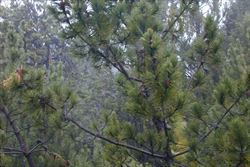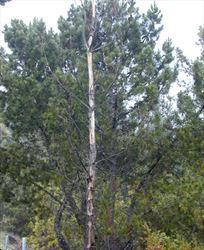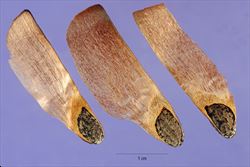Click on images to enlarge

habit (Photo: Forest and Kim Starr, USGS)

habit (Photo: Forest and Kim Starr, USGS)

branches with leaves and clusters of young male cones (Photo: Forest and Kim Starr, USGS)

close-up of needle-like leaves, which are grouped in pairs with their bases enclosed in a sheath (Photo: Forest and Kim Starr, USGS)

leaves and immature female cone (Photo: Forest and Kim Starr, USGS)

close-up of female cone with prominent projections on the scales (Photo: Forest and Kim Starr, USGS)

un-opened mature female cone (Photo: Forest and Kim Starr, USGS)

close-up of winged seeds (Photo: Steve Hurst at USDA PLANTS Database)
Scientific Name
Pinus pinaster Aiton
Synonyms
Pinus maritima Lam.
Family
Pinaceae
Common Names
cluster pine, maritime pine, pinaster pine
Origin
Native to north-western Africa (i.e. northern Morocco and Algeria) and southern Europe (i.e. Spain, Portugal, south-western France, northern Italy and Yugoslavia).
Naturalised Distribution
Widey naturalised in southern Australia (i.e. the the ACT, southern Victoria, Tasmania, south-eastern South Australia, and the south-western and southern parts of Western Australia). Also sparingly naturalised on the central tablelands of New South Wales.
Naturalised in the UK, southern Africa, New Zealand, southern South America (e.g. Chile and Uruguay), eastern USA (i.e. North Carolina) and Hawaii.
Similar Species
Cluster pine (Pinus pinaster), is similar to many other pine species that have become naturalised in Australia, including Aleppo pine (Pinus halepensis), slash pine (Pinus elliottii), radiata pine (Pinus radiata) and Caribbean pine (Pinus caribaea). These species can be distinguished by the following differences:
- cluster pine (Pinus pinaster) has relatively large slightly symmetrical or asymmetrical cones (9-20 cm long) that are almost stalkless (i.e. sessile). Its leaves are relatively long (10-30 cm long) and usually borne in groups of two.
- Aleppo pine (Pinus halepensis) has relatively small symmetrical cones (5-14 cm long) that are borne on curved stalks 10-30 mm long. Its leaves are relatively short (4-12 cm long) and usually borne in groups of two.
- slash pine (Pinus elliottii) has relatively large symmetrical cones (7-20 cm long) that are borne on short stalks. Its leaves are relatively long (15-30 cm long) and borne in groups of two or three (usually in twos).
- radiata pine (Pinus radiata) has relatively large asymmetrical cones (7-17 cm long) that are borne on short curved stalks. Its leaves are relatively short (8-15 cm long) and usually borne in groups of three (rarely in twos).
- Caribbean pine (Pinus caribaea) has relatively small symmetrical cones (5-12 cm long) that are borne on short stalks. Its leaves are relatively long (15-30 cm long) and usually borne in groups of three (rarely in twos, fours or fives).
Notes
Cluster pine (Pinus pinaster) is regarded as an environmental weed in Victoria, South Australia and Western Australia, and as a potential environmental weed or "sleeper weed" in other parts of southern Australia.

